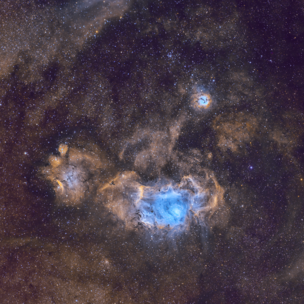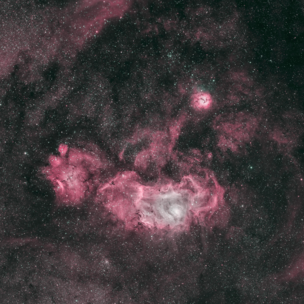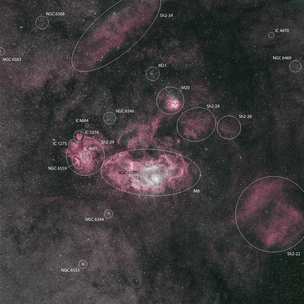Sagittarius Specials
0
7
Sagittarius Specials
The angular extent of Messier 8, the Lagoon Nebula, is ideally suited for CHI-2 or CHI-4, but I haven't been able to observe it with those telescopes. However, while the field of view of CHI-1 captures only part of this nebula, the AUS-2 Takahashi can be used to observe the wider region of sky; and while the plate scale in this case is a bit small, the detector is big enough to allow cropping, permitting a (digital) zoom into the regions of greatest interest.
The crop shown here as the main image is a Hubble-palette rendering. As well as M8, the much smaller Trifid Nebula, M20, can be seen (to the NW; upper right in this frame), along with several less well-known clusters and nebulae, identified in the accompanying annotated full-frame view.
In RGB images, M20 appears as a red nebula embedded in a blue halo. The red light comes from H-alpha gas emission, which shows up clearly in this narrow-band composition. The blue halo, however, results from the light of hot, blue stars scattered off of dust. This scattered starlight barely registers in narrow-band.
An alternative, pseudo-RGB, rendition is included for comparison. Of course, while this palette gives an arguably more 'natural' appearance, it still doesn't emphasize any scattered continuum light.
The crop shown here as the main image is a Hubble-palette rendering. As well as M8, the much smaller Trifid Nebula, M20, can be seen (to the NW; upper right in this frame), along with several less well-known clusters and nebulae, identified in the accompanying annotated full-frame view.
In RGB images, M20 appears as a red nebula embedded in a blue halo. The red light comes from H-alpha gas emission, which shows up clearly in this narrow-band composition. The blue halo, however, results from the light of hot, blue stars scattered off of dust. This scattered starlight barely registers in narrow-band.
An alternative, pseudo-RGB, rendition is included for comparison. Of course, while this palette gives an arguably more 'natural' appearance, it still doesn't emphasize any scattered continuum light.
SPECIFICATIONS
Telescope
AUS-2 Takahashi FSQ-106ED
Camera
FLI PL16803
Location
Heaven's Mirror
Date of observation
2020-05/06
Filters
SHO (9,6,6 x 450s)
Processing
Pixinsight, Photoshop, TopazAI
Credits
ian howarth/Telescope Live






